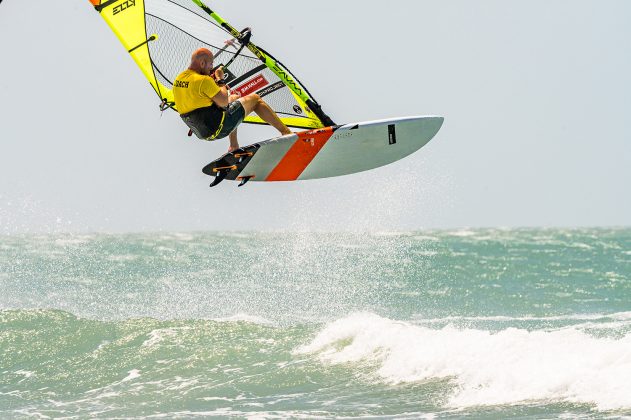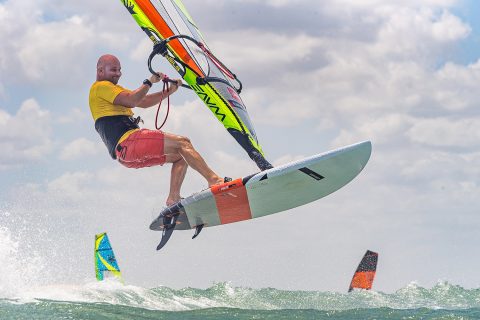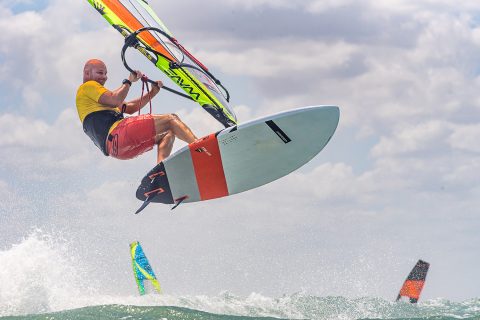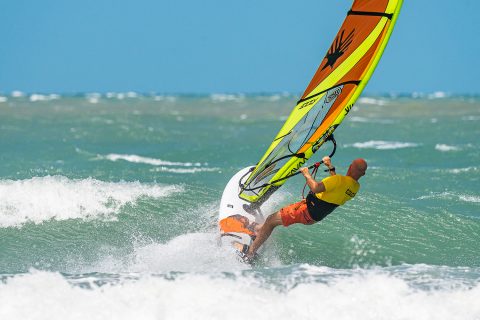JEM HALL
MOVE ON UP – WINDSURFING TECHNIQUE
JUMPING PHASES
Jem Hall talks us through the phases of jumping!
Photos by Eye Sea You Photo
This month I will cover how to break the jump down into its crucial phases so you can gain competence and enjoy the freedom of flight. Like most moves I coach, people often only consider the main part and not the preparation or a smooth exit.
The phases are: pre-pop, pop, in-flight and landing. Focusing on these phases individually will see you get more air, stay there for longer, land more smoothly and perhaps even carry some speed out of the exit, sounds great right?
PRE-POP
The pre-pop phase is the line you take to the jump and the action of unhooking to set you up for a smooth transition into the ‘pop’ phase. For this article we are looking at unhooked jumping, as this is the best and safest way to learn and improve your jumps. It will also equip you with a nice set-up for forays into rotational jumps like forward and back loops. I urge you to read my “Changing Lines” piece from the Jan/Feb ’21 issue (also available on windsurf.co.uk), as it extols the virtues of gaining speed and fin lift to give you smoother and better airtime. Your primary targets in your pre-pop are to:
- Scan ahead and read your opportunities to jump and select a wave / big chop to launch off. This will help you choose your sailing line.
- Get some speed up to lighten the rig, and also give you more options of sailing line.
- Absorb the bumps you are not going to jump by really sucking your knees up to your chest to avoid unnecessary airtime, and therefore speed loss.
- As you progress you can venture towards doing long flat low planing jumps prior to boosting your biggest air off your chosen ramp.
- Unhook smoothly by bending your arms only, and then maintain speed by pulling down on the boom.
- Aim to unhook early so you do not upset the board in your pop phase.
- Get over the board in readiness to pop at least 5-10 metres before the wave / big bump. Getting over the board early will really help you to be settled in readiness to pop at the right time.
- Rig in and toes down with rear heal close to your bottom, gives you good flight and a nice touchdown.
POP
This is the technique of releasing the board from the water so that the wave can assist in sending both you and your kit to soar higher. A good pre-pop line will give you plenty of time to get into your pop position, with good board speed and a light rig. So once you are getting closer to your ramp, your main targets to pop and then fly are:
- Get over the board with a very bent back leg! This has to be done so that when you perform your popping actions, the tail actually goes down and thereby the nose goes up. It will also allow you to sheet the sail out slightly.
- Keep speed just before the ramp by pulling down on your front arm, but then turn your hips a quarter turn, to face slightly forward. This will release mast foot pressure so the nose begins to release.
- POP using the Four Ps: PUSH down on the back leg (to send the nose), PULL up on your front leg, PULL up on your front arm, and lastly PULL up on your rear leg to release the tail and move you towards an effective in-flight position.
- POP off your toes. This will feed the wind under the board and again move you more swiftly into a nice in-flight position. It is also how we jump on land, off our toes and not our heels.
- Experiment with different amounts of back leg push or front arm / leg pull in order to really feel what works and what it does to your height. You would be surprised how so many people don’t pull up on the front leg / arm to pop!
- After a few jumps you can then start to review where the best ramps in the break are, and perhaps what section of the wave is best. Then you can input this into choosing the right line, and set-up to meet these.
- Looking forward to spot your landing. Sail starting to open up. Legs still scissoring to position tail upwind of nose. Landing gear coming down, but not too early.
IN-FLIGHT
An effective pop will help you get into an efficient in-flight position, from where you can use the wind, and your kit’s position, to propel you further up and along. There are a lot of actions taking place in the air, so it is best to work from the bigger body movements towards the smaller more subtle actions. Focus on:
- Falling outboard in the air. You took off over the board and so now you have to fall back outboards. This will pull the rig over your head so it acts like a wing. It will also position you to push the board downwind and lift the tail and rail further. You cannot scissor if you are over the board.
- Pulling the rig in with a bent front arm. I liken this to ‘licking the boom’ when coaching. This will lift the mast foot, so you don’t fall out of the sky, and it will again help you use the rig as a wing.
- Push the nose downwind. Falling outboard means you can then scissor the nose off the wind, and then you can lift the tail. Getting the board off the wind in the air keeps you up there for longer and gives you a better landing. The more extended your front leg is the better.
- Pull up on the tail. You started this process in your pop, so now continue it into getting your rear heal close to your bottom. This will get the wind under the board, and also give you a better touchdown.
- Push down on your toes. Popping off your toes helps this and this action will get the rail up, so again the wind can propel and float the board for higher, longer and safer airtime.
- Look forward. In order to assess your landing zone and when to begin your descent process, look forward.
- Land with a bent back leg, sail not too sheeted in and arms extended. This will help you land softly and catch some wind for a smooth getaway.
LANDING
Many people fall out of the air in their jumps, as they have not focused on how to actually land. Harder landings also come from a poor in-flight position, i.e. not enough tuck. Follow these tips in order to give you a nice touchdown, and hopefully a clean getaway too:
- Hold the tuck! This is the best landing tip ever as a lot of people drop their landing gear too early. Keep the tail up and only drop it just before you land.
- Open the sail by sheeting it out and beginning to extend your arms.
- Actively place your tail upwind of the nose. This means rather than just dropping the tail straight down, you subtly bring it down and place it upwind. This will give you an off the wind landing which in effect will help you skim across the water and be back up to speed quicker.
- On landing, extend your arms and pull down on the boom to plane / get speed. This will stop you oversheeting, and thereby stop you falling backwards or catapulting.
- Unhooking and heading off the wind means you can gain some speed to get the sail light and absorb bumps with ease.
Kit:
Generous straps to allow you to pop off your toeside, and get the rail up in the air.
Long lines enable unhooking from a low position so you can keep speed in your pre-pop.
A big tri-fin freestyle wave board, or fast wave board, will give you good speed without too much sail power. A relatively bigger board will also get you more jumps on a run out, and over the whole session.
- To get max pop PUSH down on the back leg, to send the nose up as you PULL up hard on both the front leg and arm, and then PULL up on your back leg to release the tail.
Common mistakes
- PROBLEM: sail heavy and hard work in the air. REASON: you are not getting sail the light in your pre-pop. ACTION: bear away to increase speed and lighten sail and also get the board ready to leave the water.
- PROBLEM: board does not leave the water as much as you had hoped. REASON: you are not getting over the board and using your whole body to send the nose and lift the board. ACTION: get over the board and really pop!
- PROBLEM: landing into the wind slowly / falling out of the sky. REASON: taking off too much into the wind. ACTION: jump across the wind and pop off your toes to get air under the board.
- PROBLEM: flying through the air with your tail very low. REASON: too late to pop. ACTION: pop earlier so you do not push straight through the top of the wave.
- PROBLEM: landing and stopping. REASON: over sheeting on landing, or pulling in the rig upon touchdown, and often landing into the wind. ACTION: take off across the wind, scissor the board in the air, and open your sail to let it breathe and catch the wind upon landing.
- PROBLEM: flat landing. REASON: dropping landing gear too early and sheeting in. ACTION: keep your landing gear up for longer, the higher the jump, the more bent your back leg should be on landing. Progressively sheet out as you come down and then land.
- Carving into the wind to supposedly gain more height will often see you taking off on your heelside which will both restrict your airtime and lead to a heavy into the wind landing.
Ezzy sails, RRD (boards, wetsuits & softwear), Chinook & Black Project fins sponsor Jem Hall. Get him live and direct on one of his highly acclaimed coaching holidays – check out his website www.jemhall.com for details. You can also follow him on twitter / Facebook / Instagram.







